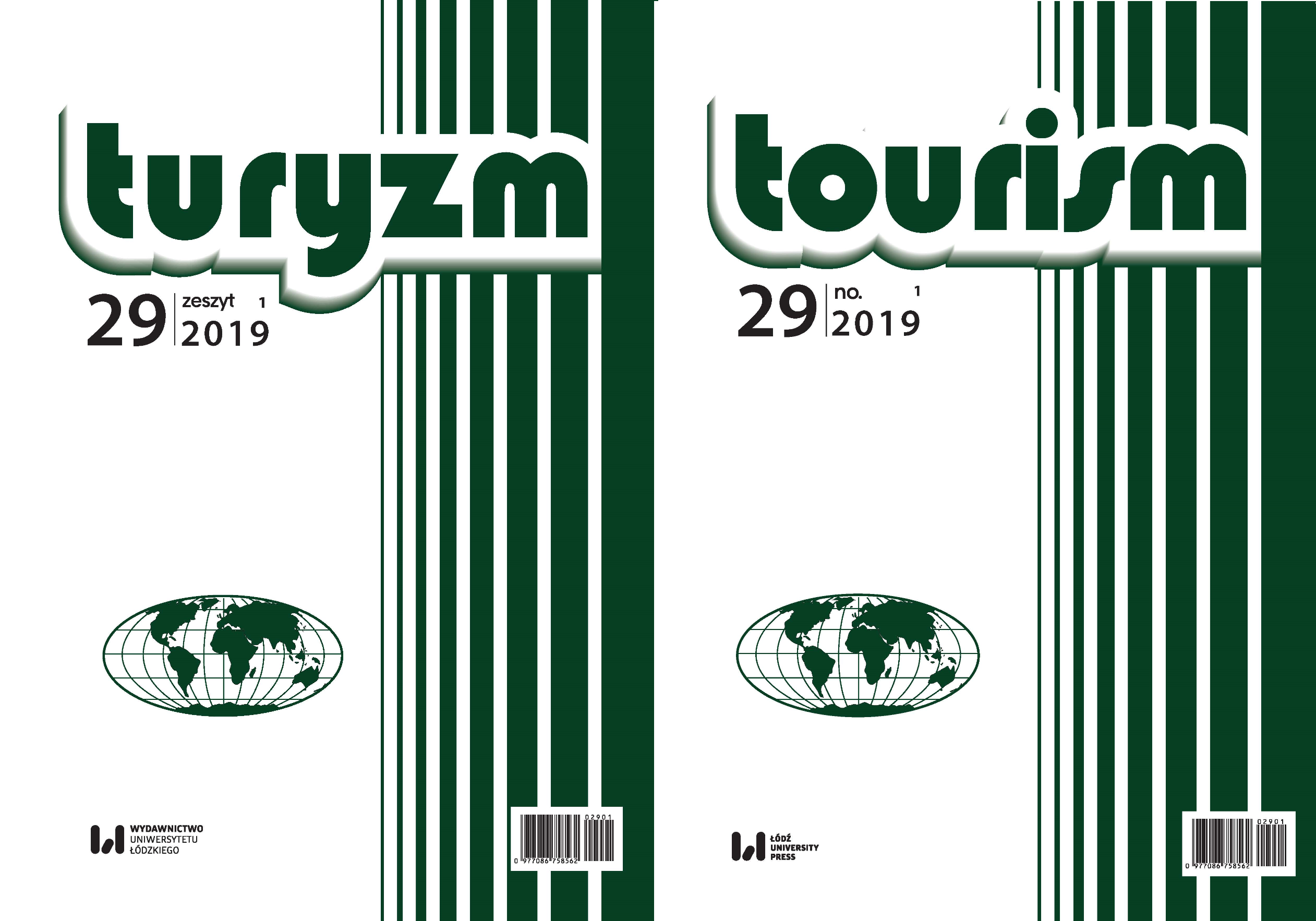Charakterystyczne elementy marek polskich miast w recenzjach dostępnych online
DOI:
https://doi.org/10.18778/0867-5856.29.1.07Keywords:
kapitał marki, destynacje, TripAdvisor, Text MiningAbstract
Celem pracy jest zidentyfikowanie charakterystycznych elementów marek polskich miast oraz wskazanie podobieństw i różnic występujących pomiędzy nimi. Praca ma dać odpowiedź na następujące pytania badawcze: Które elementy w istotny sposób wpływają na odróżnianie marek badanych miast w recenzjach dostępnych online? Które z badanych miast są do siebie najbardziej zbliżone pod względem elementów marki, a które różnią się pod tym względem? Dane do analizy pobrano z serwisu TripAdvisor. Były to opinie dotyczące rejonów koncentracji ruchu turystycznego – starych rynków lub starych miast – pięciu polskich miast: Poznania, Wrocławia, Krakowa, Gdańska i Warszawy (N = 5125). Przeprowadzone analizy pozwoliły zidentyfikować unikatowe elementy marek badanych miast i wskazać podobieństwa oraz różnice występujące pomiędzy markami.
Downloads
References
Aaker, D.A. (2009). Managing brand equity. Capitalizing on the value of a brand name. New York: The Free Press.
Google Scholar
Allahyari, M., Pouriyeh, S., Assefi, M., Safaei, S., Trippe, E.D., Gutirrez, J.B., Kochut, K. (2017). A brief survey of Text Mining: classification, clustering and extraction techniques. Halifax: ArXiv e-prints, KDD Bigdas.
Google Scholar
Boo, S., Busser, J., Baloglu, S. (2009). A model of customer-based brand equity and its application to multiple destinations. Tourism Management, 30, 219–231.
Google Scholar
Brown, G., Getz, D. (2005). Linking wine preferences to the choice of wine tourism destinations. Journal of Travel Research, 43 (3), 266–276.
Google Scholar
Buhalis, D. (2000). Marketing the competitive destination of the future. Tourism Management, 21 (1), 97–116.
Google Scholar
Cantallops, A.S., Salvi, F. (2014). New consumer behavior: A review of research on eWOM and hotels. International Journal of Hospitality Management, 36, 41–51.
Google Scholar
Casalo, L.V., Flavian, C., Guinaliu, M., Ekinci, Y. (2015). Do online hotel rating schemes influence booking behaviors? International Journal of Hospitality Management, 49, 28–36.
Google Scholar
Florek, M. (2014). Kapitał marki miasta zorientowany na konsumenta. Źródła i pomiar. Poznań: Wydawnictwo Uniwersytetu Ekonomicznego w Poznaniu.
Google Scholar
Hill, M.O. (1974). Correspondence analysis: A neglected multivariate method. Journal of the Royal Statistical Society. Series C (Applied Statistics), 23 (3), 340–354.
Google Scholar
Jalilvand, M.R., Shekarchizadeh, S.S., Samiei, N. (2011). Electronic word-of-mouth: Challenges and opportunities. Procedia Computer Science, 3, 42–46.
Google Scholar
Jalilvand, M.R. (2016). Word-of-mouth vs. mass media: Their contributions to destination image formation. Anatolia, 28 (2), 151–162.
Google Scholar
Keller, K.L. (1993). Conceptualizing, measuring and managing customer-based brand equity. Journal of Marketing, 57 (1), 1–22.
Google Scholar
Kenneth, S., Bordens, K.S., Abbott, B.B. (2008). Research design and methods. A process approach. Wyd. 7. New York: McGraw-Hill.
Google Scholar
Kladou, S., Mavragani, E. (2015). Assessing destination image: An online marketing approach and the case of TripAdvisor. Journal of Destination Marketing & Management, 4 (3), 187–193.
Google Scholar
Konecnik, M., Gartner, W. (2007). Customer-based brand equity for a destination. Annals of Tourism Research, 34 (2), 400–421.
Google Scholar
Kotler, P. (1994). Marketing. Analiza, planowanie, wdrażanie i kontrola. Warszawa: Gebethner & Ska.
Google Scholar
Kotler, P.T., Bowen, J.T., Makens, J., Baloglu, S. (2017). Marketing for hospitality and tourism (7th Edition, Global Edition). Essex: Pearson.
Google Scholar
Kuhzady, S., Ghasemi, V. (2019). Factors influencing customers’ satisfaction and dissatisfaction with hotels: A Text-Mining approach. Tourism Analysis, 24 (1), 69–79.
Google Scholar
Leicht, T. (2016). Establishing external validity for consumerbased place brand equity scales: Mission impossible or a matter of approach? W: T.C. Melewar, K. Dinnie, C. Fona, C. Dennis (red.). Conference proceedings of inaugural conference of the international place branding association (s. 248–256). London: Middlesex University.
Google Scholar
Liu, Y., Huangb, K., Bao, J., Chenc, K. (2019). Listen to the voices from home: An analysis of Chinese tourists’ sentiments regarding Australian destinations. Tourism Management, 71, 337–347.
Google Scholar
Lucarelli, A. (2012). Unravelling the complexity of „city brand equity”: A three-dimensional framework. Journal of Place Management and Development, 5 (3), 231–252.
Google Scholar
Nakaima, K., Marchiori, E., Cantoni, L. (2019). Identification of competing destination brand: The case of Okinawa island. W: J. Personen, J. Neidhardt (red.). Information and communication technologies in tourism (s. 172–183). Cham: Springer.
Google Scholar
Niezgoda, A. (2017). Rola doświadczeń i relacji z podróży w kształtowaniu wizerunku miejsca. Marketing i Zarządzanie, 1 (47), 221–228.
Google Scholar
Nowacki, M. (2017). Atrakcje turystyczne światowych metropolii w opinii użytkowników TripAdvisora. Studia Periegetica, 3 (19), 23–41.
Google Scholar
Nowacki, M. (2019). World cities’ image in TripAdvisor users’ reviews. e-Review of Tourism Research (eRTR), 16 (2/3), 146–155.
Google Scholar
Papadopoulos, N. (2004). Place branding: Evolution, meaning and implications. Place Branding, 1 (1), 36–49.
Google Scholar
Pike, S. (2005), Tourism destination branding complexity. Journal of Product & Brand Management, 14 (4), 258–259.
Google Scholar
Simeon, M.I., Buonincontri, P., Cinquegrani, F., Martone, A. (2017). Exploring tourists’ cultural experiences in Naples through online reviews. Journal of Hospitality and Tourism Technology, 8 (2), 220–238.
Google Scholar
Smith, M., Sulyok, J., Jancsik, A., Puczkó, L., Kiss, K., Sziva, I., Papp-Váry, Á.F., Michalkó, G. (2018). Nomen est omen – tourist image of the Balkans. Hungarian Geographical Bulletin, 67 (2), 173–188.
Google Scholar
Stanisz, A. (2007). Przystępny kurs statystyki z zastosowaniem STATISTICA PL na przykładach z medycyny. Tom 3: Analizy wielowymiarowe. Kraków: StatSoft.
Google Scholar
Tamajón, L.G., Valiente, G.C. (2015). Barcelona seen through the eyes of TripAdvisor: Actors, typologies and components of destination image in social media platforms. Current Issues in Tourism, 20 (1), 33–37.
Google Scholar
TripAvisor. Pobrano z: https://tripadvisor.mediaroom.com/uk-about-us (18.02.2019).
Google Scholar
TripAvisor. Media Centre. Pobrano z: https://tripadvisor.co.uk-about-us (15.01.2019).
Google Scholar
Web Scraper. Pobrano z: https://www.webscraper.io/ (17.01.2019).
Google Scholar
Wikipedia. Pobrano z: https://pl.wikipedia.org/wiki/Web_2.0) (18.02.2019).
Google Scholar
Woodside, A.G., Cruickshank, B.F., Dehuang, N. (2007). Stories visitors tell about Italian cities as destination icons. Tourism Management, 28, 162–174.
Google Scholar
Downloads
Published
How to Cite
Issue
Section
License

This work is licensed under a Creative Commons Attribution-NonCommercial-NoDerivatives 4.0 International License.










